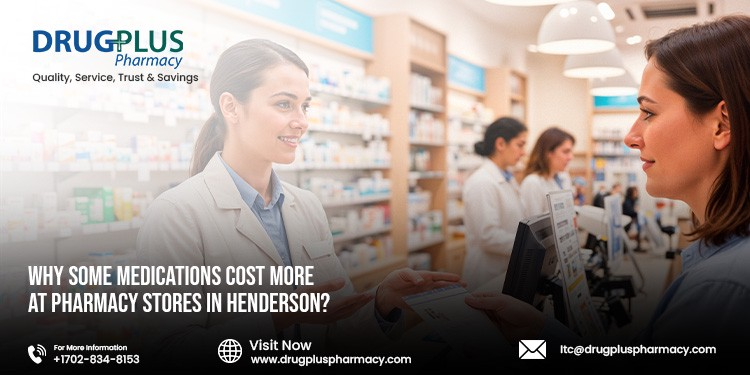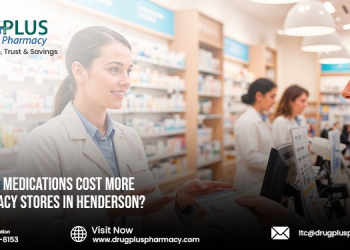Have you ever gone to the pharmacy, handed over your prescription, and then just stared at the total thinking, “Why is this one so freaking expensive?”
Like, one bottle costs barely a few bucks, and the next one feels like it’s out to ruin your budget — and both look exactly the same. It makes zero sense, right?
If that’s ever happened to you at a pharmacy store in Henderson, trust me — you’re not alone. So many people get caught off guard by how unpredictable medicine prices can be. But here’s the thing: they’re not actually random. There’s a whole chain of reasons behind every price tag — how the drug was made, who sells it, what kind it is, and even how it’s stored. Every tiny step adds a few extra dollars.
So let’s talk about it in plain words — no fancy medical terms, no confusing explanations — just the real reasons some medicines cost a lot more than others.
Brand, Generic, and Specialty Drugs — What’s the Difference?
The biggest reason prices jump around is simple: what kind of drug you’re buying.
- Brand-name drugs are like the “original” songs. The company that made them spent years in labs testing, researching, and proving that they actually work. That takes millions and sometimes billions of dollars. So when they finally release it, the price is sky-high because they’re trying to earn that money back.
- Generic drugs are like cover songs. Same tune, different artist. Once the patent for the brand drug expires, other companies are allowed to make their own versions using the same formula. And that’s why they’re way cheaper. According to the FDA, generics are about 85% less expensive than brand-name drugs. Same medicine, smaller bill.
- Specialty drugs are the real heavy hitters. The ones made for serious or rare conditions like cancer or multiple sclerosis. They need advanced tech, super careful handling, and special storage, which makes them crazy expensive.
So yeah, sometimes that high price has nothing to do with what’s in the bottle and everything to do with what it took to get that bottle to you.
The “Middlemen” Who Add to the Cost
There’s a whole chain between the company that makes your medicine and the pharmacy store in Henderson that sells it.
In the U.S., three main players affect prices:
- Manufacturers (who make the drug)
- Pharmacy Benefit Managers (PBMs) (who negotiate prices with insurance companies)
- Pharmacies and wholesalers
PBMs play a huge role. They decide which drugs qualify for discounts and which your insurance will cover. The problem? Their system of rebates and markups is complicated and not always transparent.
According to a U.S. Government Accountability Office (GAO) report, PBMs handle 90% of prescription claims in America, and their hidden fees can add up to 20–30% to the cost of a drug.
That’s why the same medication might cost less at one pharmacy than another, even within Henderson.
Insurance Plans — Who Matters covers you
If you have insurance, your cost depends on what your plan covers. Some drugs are labeled as “preferred” and come with a small co-pay, while others might be considered “non-preferred,” which means a higher price.
For example:
- One plan might cover a cholesterol drug fully.
- Another plan might make you pay half the cost out of pocket.
If you don’t have insurance, it gets trickier. You’ll often pay the full retail price, unless you use a discount card or buy from an online pharmacy store, which can offer lower prices.
Location and Type of Pharmacy
Believe it or not, where you buy your medicine can actually change how much you pay.
Here’s how it works — smaller, independent pharmacies usually charge a little more. It’s not because they’re trying to overcharge you. They just don’t buy medicine in giant batches like big chains do. When you don’t have bulk deals, you pay more per box, and that price trickles down to customers.
On the other hand, chain pharmacies and online stores can often sell certain medicines for less because they buy in massive quantities. Think of it like buying from Costco versus a corner shop; bulk always wins in pricing.
Manufacturing and Supply Chain Issues
Another big reason some medicines cost more? They’re simply harder (and pricier) to make.
Take insulin, for example, or certain cancer drugs. These need very specific ingredients, controlled storage temperatures, and constant safety testing. All that special handling adds to the cost.
And when something goes wrong in the supply chain, like a shortage of ingredients or factory shutdowns, prices can spike fast. During 2023, nearly 300 medications in the U.S. faced supply shortages, according to the American Society of Health-System Pharmacists (ASHP).
So, when supply drops but people still need the same medicine, the price tag naturally climbs.
It’s basic economics: less product + more demand = higher cost at the counter.
The “List Price” Confusion
Here’s something most people don’t realize: the price you see on your pharmacy receipt isn’t always the real price.
Drug manufacturers set what’s called a “list price,” kind of like a car’s sticker price. But that’s not necessarily what anyone — not your insurance, not even the pharmacy — actually pays. Behind the scenes, there are discounts, rebates, and deals between manufacturers, wholesalers, and insurers that change the final number.
A 2023 report from IQVIA, a global healthcare analytics company, found that while drug list prices rose by about 5%, the real prices (after rebates and negotiations) only went up by less than 2%.
So, even though it looks like medication prices keep shooting up, what you pay out-of-pocket depends on a messy web of behind-the-scenes deals most of us never see.
Manufacturing and Supply Chain Issues
Some drugs are just expensive to make. Think of insulin or cancer medications; they require special ingredients, storage temperatures, and testing.
When something goes wrong in production, like a shortage of raw materials or factory delays, prices can shoot up quickly. For example, during 2023, nearly 300 medications in the U.S. faced supply shortages, according to the American Society of Health-System Pharmacists (ASHP).
Short supply + high demand = higher prices at the counter.
The “List Price” Confusion
Here’s something most people don’t know: the price you see on a receipt (the list price) isn’t always what anyone actually pays.
Manufacturers set a list price, but after rebates, discounts, and insurance deals, the actual cost changes. It’s like how a car has a “sticker price,” but the dealer might give a discount.
A 2023 report from IQVIA, a global healthcare analytics company, showed that even though drug list prices increased by about 5%, the net prices (after rebates) grew less than 2% because of all the behind-the-scenes negotiations.
So, when your pharmacist tells you your co-pay is $80 while your friend pays $40 for the same medicine, it’s probably due to those hidden price adjustments.
Why Online Pharmacy Stores Can Be Cheaper?
Ordering medicine from an online pharmacy store can sometimes save you a lot, and here’s why:
- They buy in bulk and store everything in one central location.
- They have fewer staff and lower rent costs.
- Some skip middlemen altogether, connecting directly with manufacturers.
For example, GoodRx and Cost Plus Drugs (Mark Cuban’s company) have shown that some common prescriptions can cost up to 80% less online than at traditional retail pharmacies.
But be cautious, not all online pharmacies are safe. Always check if the site is verified by the National Association of Boards of Pharmacy (NABP) or has a “pharmacy” domain.
How to Save on Prescriptions in Henderson
Here are a few simple ways to keep your medicine bill from growing out of control:
- Ask for generics. They’re just as effective and much cheaper.
- Compare prices. Use tools like GoodRx or check different pharmacy stores in Henderson, you’d be surprised how much they vary.
- Use an online pharmacy store. For routine refills, mail-order can be easier and more affordable.
- Look for manufacturer coupons or patient assistance programs.
- Talk to your pharmacist. Seriously, pharmacists often know ways to save that your doctor or insurer might not mention.
Furthermore, here are some tips on the Midnight Flu and how a 24-Hour Drugstore Helps.
The Bottom Line
The next time you’re at the counter and see a higher-than-expected price, remember it’s not random. Behind every number is a mix of patents, policies, middlemen, and production costs that make up the complex world of drug pricing.
But you’re not powerless. With a little research, the right questions, and some price comparisons between your local pharmacy store in Henderson and trusted online pharmacy stores, you can find ways to spend less, without compromising your health.
After all, good health shouldn’t come with a shocking price tag.
FAQs (Frequently Asked Questions)
Why do medications cost more at some pharmacy stores in Henderson than others?
Prices vary due to supplier rates, brand vs. generic options, insurance contracts, and location-based operating costs that affect overall pricing.
Are online pharmacy stores cheaper than local pharmacy stores in Henderson?
Yes, many online pharmacies offer lower prices since they have fewer overhead costs and access to bulk purchasing discounts.
Do insurance plans affect medication prices at pharmacy stores in Henderson?
Absolutely. Insurance coverage, copays, and preferred pharmacy networks play a big role in determining how much you pay for prescriptions.
Why are brand-name drugs more expensive than generic medicines?
Brand drugs include research, marketing, and patent costs, while generics are cheaper because they skip those expenses but use the same ingredients.
How can I save money on prescriptions at Henderson pharmacy stores?
Compare prices, use pharmacy discount cards, switch to generics, and ask pharmacists about ongoing promotions or lower-cost alternatives.






